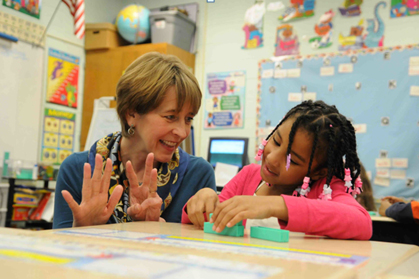Thursday, Feb 14, 2013
The innovative School of Education program in early math learning answers President Obama’s call for improved science, technology, engineering and mathematics (STEM) education.
by Dr. Heather K. Warren-Khot
Three “generations” of professionals from Rider’s School of Education are partnering with a public urban-rim elementary school in Ewing, N.J., to provide creative hands-on lessons in early mathematical thinking for young learners.
This unique partnership involving a current Rider faculty member, a Rider student teacher, and two talented Rider alumnae, brings the research of Dr. Judith Fraivillig, associate professor of Mathematics Education, into the elementary classroom. Josephine Stevens ’05, a first-grade teacher in an inclusion classroom at Ewing’s Parkway Elementary School, and Jacqueline Bruno ’03, the special education support teacher, coordinated with student teacher Gina Maccarone ’12 to bring this applied research to life.
The cutting-edge initiative has these educators teaching place value—a difficult early numeracy concept to master, but one essential for moving ahead to more complex mathematics—in small daily increments. This minor change in the teachers’ daily routine could have meaningful, long-lasting impact on the Ewing students. Using touchable, tangible blocks called Digi-Blocks©, the young mathematicians discover how a collection of 10 individual units together creates one complete “set” of ten.
Digi-Block© counting is a regular practice in Stevens’ classroom at Parkway. Collectively, the students count the days they have been in school at their daily morning meeting using the blocks. They record their findings on a graphical device with ten squares per card, called a Ten Frame.
According to Fraivillig, the irregularity of English counting words creates challenges for United States students learning how to count aloud, making it less intuitive and more about memorization. As an alternative, the group at Parkway shows students how to use the Asian counting words. For example, while the amount of 12 is given the irregular name “twelve” in the English language, Asian children learn it as “one-ten two.” This more descriptive language supports the students’ understanding of place value.
“This focus on the number 10 really helped the children with counting by ten, addition, math facts, and place value,” said Stevens, the classroom teacher. Fraivillig is currently analyzing the impact of the program, but the teachers’ observations of their students’ skills speak volumes.
“Kids at this early age need everything to be modeled,” said Bruno, the support teacher. “This program gave the students tangible ways to visualize what it means to be counting by ten, as well as to see that as the numbers were getting higher, there is still a power of ten underneath that number.”
Bruno was particularly energized to collaborate with Fraivillig, her former professor at Rider.
“I remember her math class fondly and was excited to once again feel the positive energy she gives off,” Bruno said.
The Rider teaching lineage, from Fraivillig to Stevens and Bruno, is also extended to a third “generation,” through the professional training of Maccarone, the student teacher.
“It was a chance to give back to Rider and help Gina further develop her teaching skills,” Bruno said, with agreement from her colleague.
“It is a two-way street with my student teachers,” Stevens explained. “Hopefully they learn from me, and I definitely learn from them!”
Fraivillig is proud, not only of the way the innovative program is helping the youngsters at Parkway Elementary, but of the work her former students have done to bring it to life.
“Rider students can learn all about educational theories on campus, but it is not until they become immersed in classrooms, working with teachers and children, that they start to see how their own teaching can be guided by what they have learned at Rider,” she said. “These Rider connections have the ability to make a big difference in small ways.”
Funding for the program was made possible through a grant to Parkway Elementary School due to its Title I status, which provides financial assistance to local educational agencies and schools with high numbers or high percentages of children from low-income families to help ensure that all children meet challenging state academic standards.

